Orange tabby cats are a vibrant and distinct category within the feline family, recognized for their striking coat patterns of bold orange stripes and warm ginger tones. Their appearance is not determined by breed, but rather by the coloration genetics of their fur, making them a common sight among various cat breeds. The lifespan of an orange tabby cat can be of great interest to current or prospective pet owners, as it pertains directly to the time they may expect to spend with their feline companion.

While genetics play a significant role in the health and longevity of any animal, the average lifespan of orange tabby cats typically ranges from about 12 to 20 years. This is contingent upon many factors including environment, diet, and proactive healthcare. Indoor orange tabbies often enjoy a longer life due to protection from outside dangers and consistent care. Moreover, the love and attention provided by their human families can contribute to both their physical health and psychological well-being, which are crucial for a long and happy life.
Key Takeaways
- Orange tabby cats are characterized by their unique coat pattern, not their breed.
- The average lifespan of these cats is between 12 to 20 years, influenced by various health and care factors.
- Indoor living, proper diet, and regular veterinary care are instrumental in extending an orange tabby cat’s life.
Understanding Orange Tabby Cats
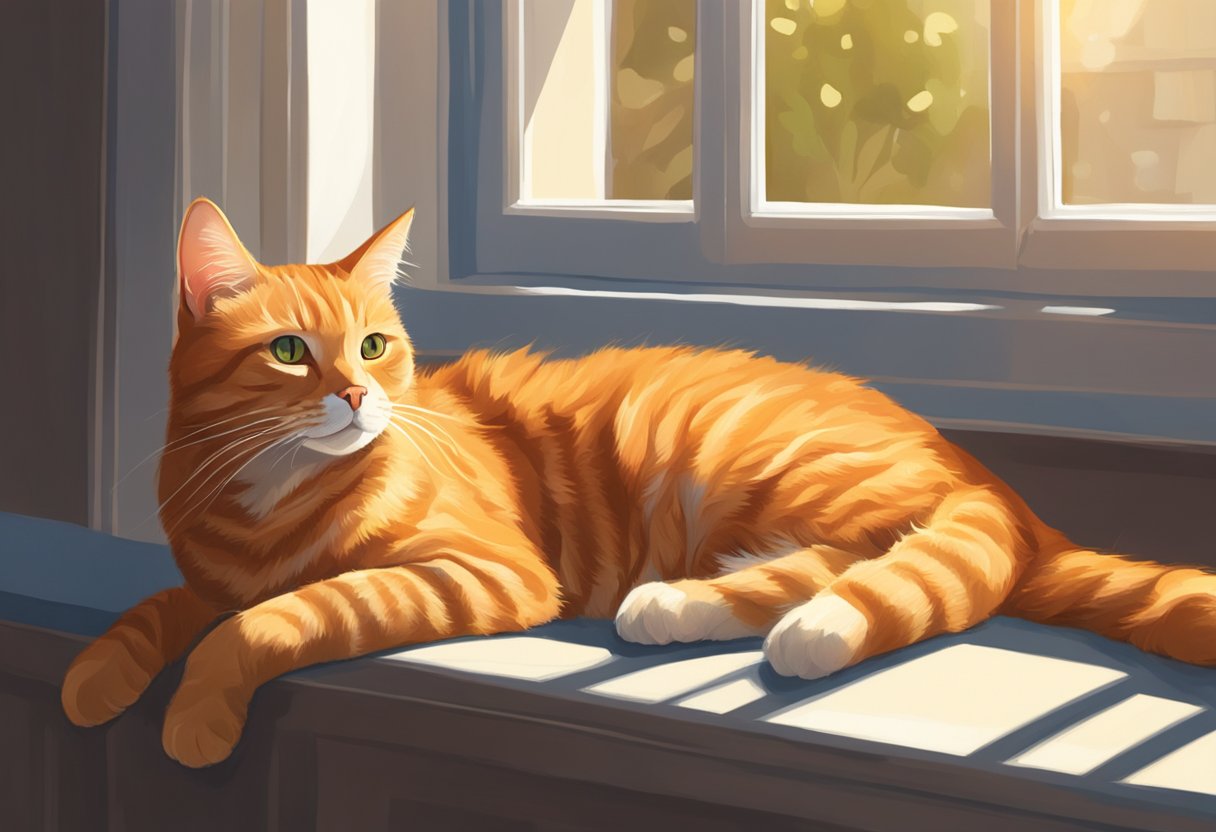
Orange tabby cats are distinguished not by their breed, but by their unique coat patterns and colors, influenced by genetics. Their personalities are often described as friendly and sociable.
Breed and Genetics
The coat pattern of an orange tabby is a result of its genetics, not a specific cat breed. Any cat, including breeds like the Maine Coon, Persian, Egyptian Mau, British Shorthair, and American Shorthair, can potentially display the orange tabby pattern. A specific gene determines the orange color in tabbies.
Coat Colors and Patterns
Orange tabby cats display various patterns such as classic, mackerel, spotted, and ticked. These patterns can be bold or subtle, with stripes, spots, and different shades of orange. The term “tabby” refers to these coat patterns, not to a breed, and each pattern has its own distinct appearance, from whirling patterns to straight lines and even speckles.
Personality Traits
Generally, orange tabbies are known for being affectionate, playful, and social animals. However, their temperament can vary widely from vocal and adorable to independent. Each cat’s personality is as unique as its coat, influenced by a combination of breed characteristics and individual traits.
Orange Tabby Cat Care

Proper care of an orange tabby cat involves close attention to their nutrition and diet, ensuring regular exercise and play, and maintaining their health and wellness. These practices are essential to prolong their lifespan and enhance their quality of life.
Nutrition and Diet
Orange tabby cats require a balanced diet that fulfills all their nutritional needs. It’s advisable to offer them high-quality cat food that is appropriate for their age and weight. Kittens, for instance, need kitten-formula food which is rich in calories and nutrients to support their growth and development. Adults, on the other hand, benefit from a diet that helps maintain an ideal weight to prevent obesity and related health issues like diabetes.
- Kitten (0-1 year): High protein, high-fat diet
- Adult (1-7 years): Balanced diet with measured portions
- Senior (7+ years): Diet tailored to lower activity levels and health needs
Exercise and Play
To prevent obesity, orange tabby cats need daily exercise and play. They are typically playful and enjoy interactive toys that stimulate their natural hunting instincts. Regular play sessions not only keep them physically fit but also provide much-needed mental stimulation. Cat owners should integrate toys and activities that encourage movement, such as:
- Interactive toys: Laser pointers, feather wands
- Puzzle feeders: Promote mental stimulation and slower eating
Health and Wellness
Regular health check-ups are vital for catching health problems early. Vaccinations, parasite control, and routine grooming are aspects of proper care that contribute to their overall health. Attention to their environment is also crucial; a clean, safe, and enriching environment can prevent stress and anxiety. Maintaining a clean litter box, providing scratch posts, and ensuring a quiet resting area are all part of a nurturing environment. Here is some critical health-related care:
- Vet Visits: At least once a year for adults, more frequently for kittens and seniors
- Dental Care: Regularly checking and cleaning teeth to prevent disease
- Grooming: Routine brushing to reduce hairballs and keep the coat healthy
Health and Lifespan
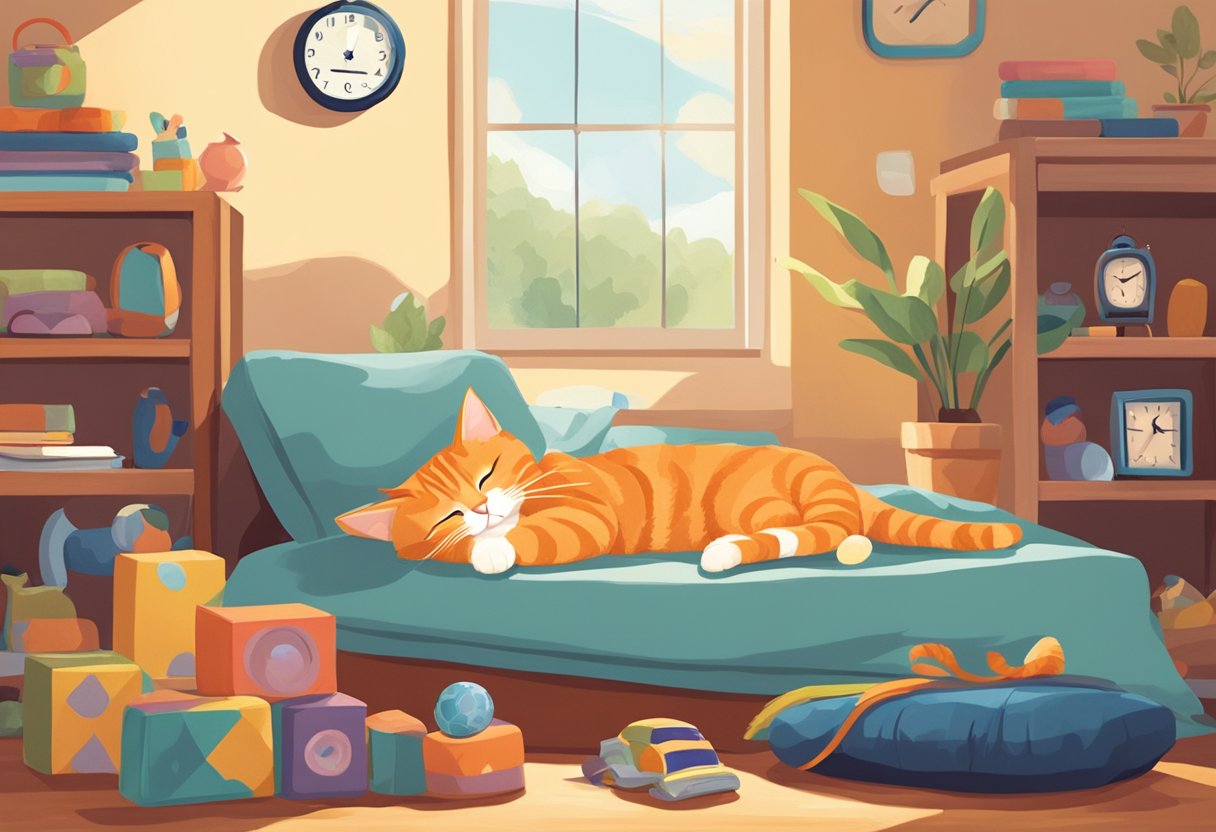
Orange tabby cats typically enjoy a lifespan of 12 to 20 years when provided with good care and a healthy environment. However, several factors, including common health issues and various elements that influence longevity, can impact this range.
Common Health Issues
Orange tabby cats may encounter certain health problems more frequently, primarily due to their genetics. Some common health issues observed in these felines include:
- Obesity: A prevalent concern, which can lead to other complications such as diabetes and joint problems.
- Diabetes: The breed’s susceptibility to weight gain can increase the risk of diabetes.
- Specific breeds like the Maine Coon and Persian may have breed-specific health challenges that could affect their overall condition and lifespan.
Factors Affecting Longevity
The longevity of orange tabby cats can be influenced by several critical factors, which include:
- Genetics: Some cats inherit genes that contribute to a longer life and better health.
- Diet and Exercise: A balanced diet and regular exercise play a vital role in the prevention of health issues like obesity and its associated risks.
- Environment: A safe, indoor environment protects them from outdoor hazards that can reduce lifespan.
- General Care: Regular veterinary check-ups ensure early detection and management of health problems. Proper dental care, vaccinations, and parasite control are also vital components of general care.
- Mental Stimulation: Keeping a cat mentally engaged through interactive play can also have a positive impact on their health and longevity.
Maintaining a healthy lifestyle for the orange tabby involves consistent management in these areas, which in turn, can lead to a happier and potentially longer life.
Social and Behavioral Aspects

Orange tabby cats possess distinctive social behaviors and temperaments that influence their interactions with humans and their lifespans. These felines are renowned for their affable nature and a strong propensity for forming bonds with their owners.
Interaction with Humans
Orange tabby cats are often typified by a friendly and affectionate temperament, which makes them well-suited for a variety of households. They are known for seeking out attention and being particularly playful, which can foster a positive and engaging environment for both the cat and its human companions. Interactions with humans can significantly impact their overall well-being, as these cats thrive in environments where they can engage in frequent play and receive regular affection.
These cats are not just social, but also exhibit a certain level of vocality when interacting with humans, which can manifest as meows, purrs, and other vocalizations to communicate their needs or desires. This expressive nature often endears them to their owners and strengthens the human-animal bond.
From the time they are kittens, orange tabby cats show a capacity for socialization, with early human interaction playing a crucial role in the development of their personality. Proper socialization can lead to a well-adjusted adult cat that is both confident and amicable.
The orange tabby’s need for attention should not be underestimated; they tend to be happiest when they are part of the family activities. Providing a consistent level of interaction and mentally stimulating play can help maintain their temperament and support a long and healthy life.
History and Origins

Tracing back the lineage of orange tabby cats reveals a rich history intertwined with human societies. These cats are not defined by breed, but by their distinctive coat pattern, which has been both adored and mythologized across cultures and time periods.
Cultural Significance
Orange tabby cats have a prominent place in cultural history, often associated with luck and fortune. The classic ginger color and its variations, from pale orange to marmalade, can be traced back to ancient civilizations. Cats resembling the modern-day orange tabby were reputedly present in Egyptian society, sometimes linked to the Egyptian Mau, and were depicted in historical Egyptian art. Some consider these cats as descendents of the African wild cat, carrying with them not just their iconic striped coats but millennia of history.
The nicknames given to orange tabby cats often reflect their distinct coat patterns and personalities. Phrases like “marmalade cat” and “ginger cat” are fondly used, while variations like the torbie—a mix between tabby and tortoiseshell—add to the diversity of this coloring. The coloration is a genetic trait, with the vibrant orange hue stemming from a particular pigment.
In popular culture, the orange tabby cat has been immortalized through iconic characters such as Garfield, solidifying their status as familiar and cherished animals. Whether referred to as calicos in some instances—though true calicos have a distinct tri-color pattern—or simply as beloved pets, these cats carry a storied legacy that continues to captivate cat enthusiasts around the world.
Adoption and Ownership
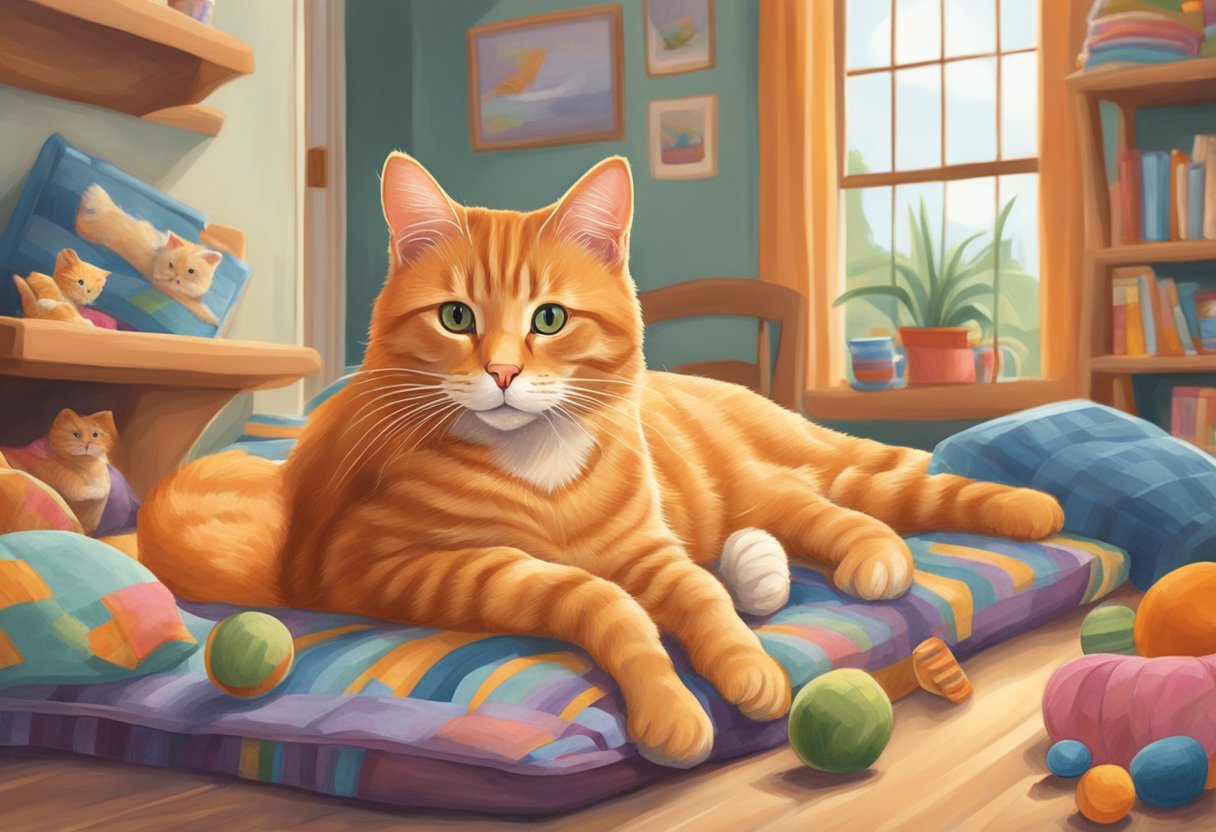
When considering the addition of an orange tabby to your family, it is essential to understand the responsibilities associated with adoption and providing long-term care. This section will guide you through Choosing the Right Cat, including the considerations of adopting from a shelter versus other avenues, and the importance of proper care.
Choosing the Right Cat
Before adopting an orange tabby, prospective owners should evaluate whether this breed aligns with their lifestyle. Shelters often provide a diverse range of tabby cats, from kittens to adult cats. While kittens can adapt more readily to new environments, adult cats often have established personalities, making it simpler to find a match for your home’s dynamic.
It’s crucial to consider the proper care of your future pet, including setting up a litter box and establishing a routine that accommodates regular feeding and playtime. When visiting a shelter, take the time to interact with the cats to gauge their personality and how well it aligns with your expectations and capacity for care. Adopting a cat should be a thoughtful decision, as it involves a commitment to providing a loving home and proper care for your new family member’s entire lifespan.
Breed-Specific Information
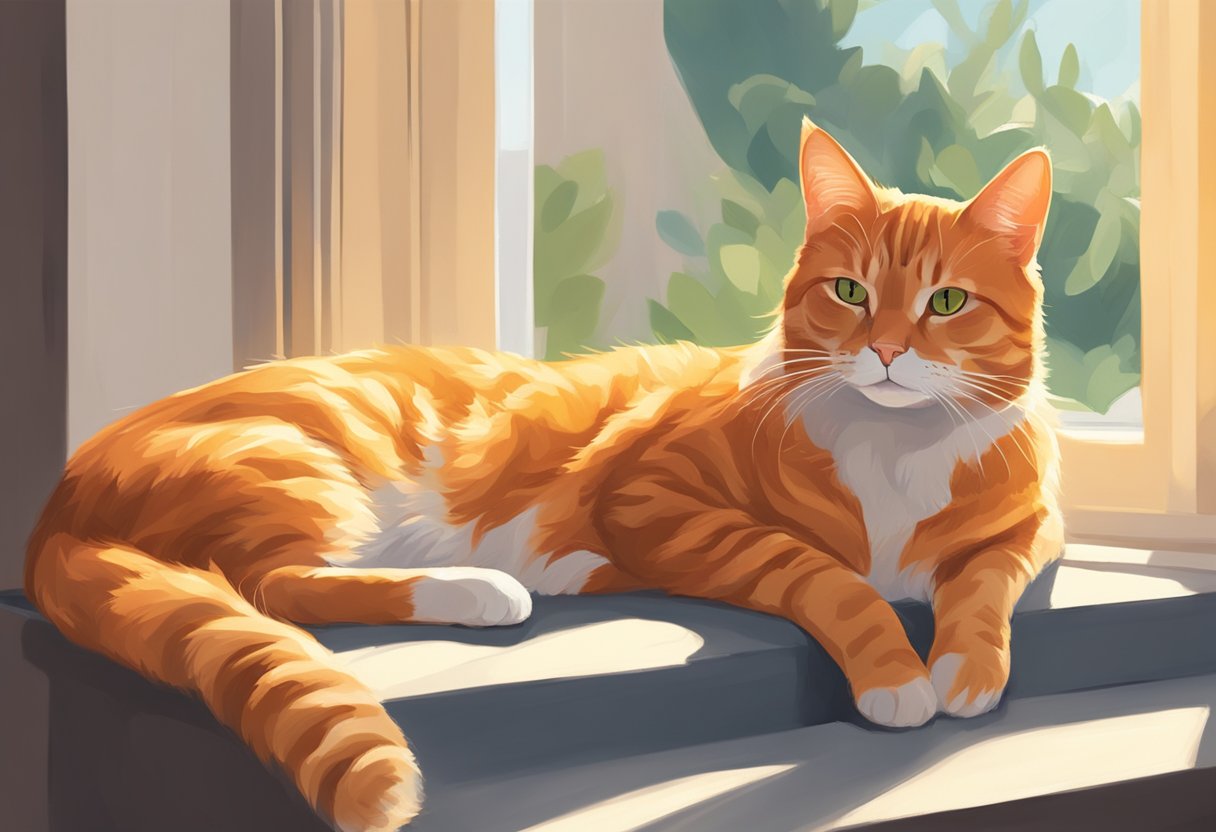
Within the diverse feline world, orange tabby cats boast a set of unique traits and a range of varieties, which are not bound to a single breed but are rather linked to distinct genetic patterns.
Unique Breed Characteristics
Orange tabby cats are distinguished by their striking coat color, which is the result of a dominant gene that produces the orange or ginger coloration. This coloration is found in many breeds, including the American Shorthair, Maine Coon, and the Abyssinian. All orange tabby cats possess the familiar M-shaped marking on their foreheads, and regardless of the breed, these cats showcase clear and distinct markings along their fur.
The term “tabby” does not refer to a breed, but to a coat pattern, and within these patterns, four types are recognized: the Mackerel, Classic, Spotted, and Ticked tabby. Tabbies may also have variations in their patterns, leading to unique combinations like the Torbie, which is a mix between a tortoiseshell pattern and a tabby.
Tabby Cat Varieties
Tabby cat patterns can appear in many different cat breeds. Mackerel tabby cats have narrow stripes that run in parallel down their sides, reminiscent of a fish skeleton, hence the name. Classic tabbies feature swirls that create a marble pattern on their sides. The much rarer spotted tabby appears in such breeds as the Egyptian Mau and is characterized by spots all over the body. The ticked tabby, sometimes seen in breeds like the Abyssinian or the American Curl, displays coloration where individual hairs are striped with alternating light and dark bands, known as agouti hairs.
Breeds like the American Bobtail, Maine Coon, Manx, and Calico can exhibit tabby patterns, showcasing the genetic diversity and wide-reaching presence of the tabby’s distinctive markings across various cat pedigrees. It is the interplay of genes that brings about the vast array of tabby coats observable in the feline population, each with its own breed-specific characteristics and lifespan implications.
Naming and Nicknames
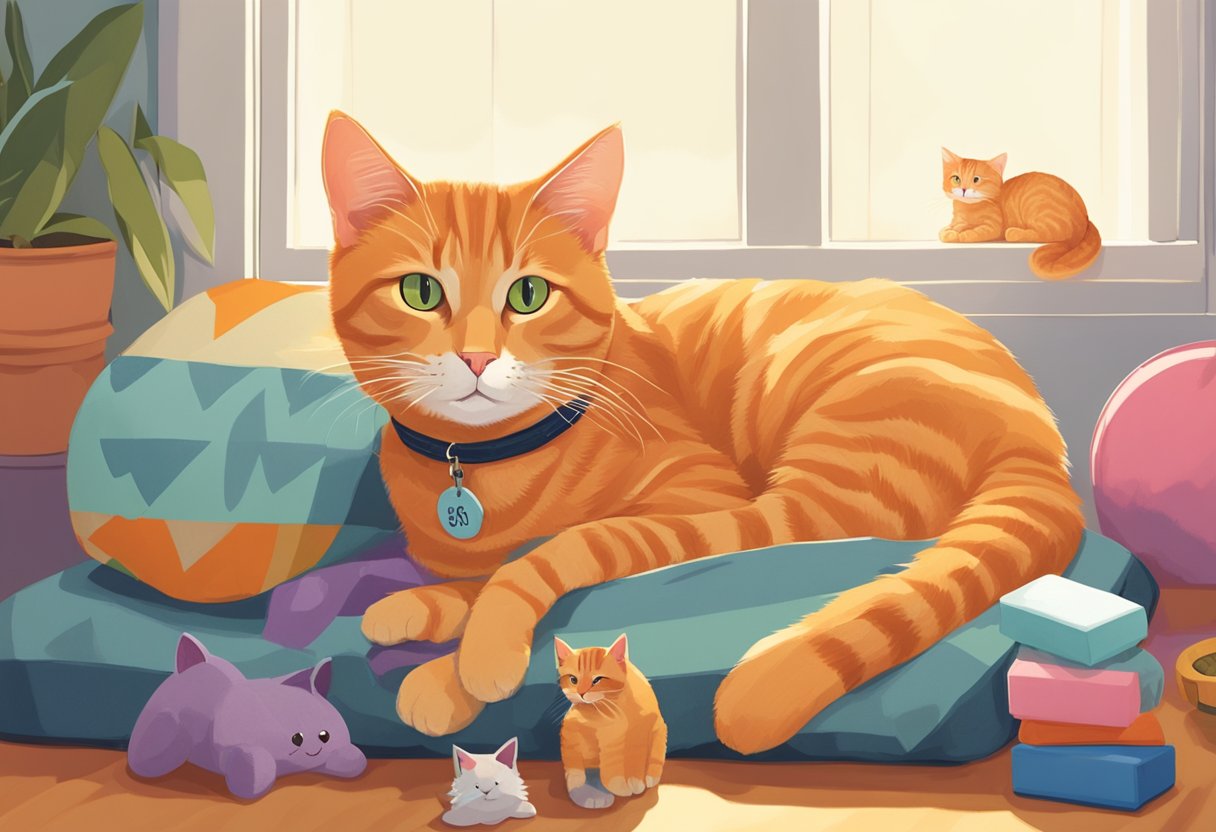
Orange tabby cats come with a vibrant fur coat that not only captures attention but also inspires a variety of affectionate nicknames. One of the most popular nicknames is “Ginger cat,” attributed to the rich, warm tones of their fur that resemble the spice. Another common term is “Marmalade cat,” which evokes the sweet, citrusy spread and aptly describes the varying shades of orange and golden hues present in their coat pattern.
Popular Nicknames for Orange Tabby Cats:
- Ginger
- Marmalade
- Tiger (for striped patterns)
- Sunshine (for their bright color)
Famous orange tabbies have influenced these nicknames as well. Garfield, the iconic comic strip character, is undoubtedly one of the most recognized orange tabby cats. His laid-back personality and distinctive color have made his name synonymous with orange tabbies.
| Characteristic | Related Nicknames |
|---|---|
| Coat Color | Ginger, Marmalade |
| Comic Strip Cat | Garfield |
| Pattern | Tiger |
| Bright Color | Sunshine |
These terms of endearment reflect not just the physical attributes, but also the warm and engaging personalities that orange tabby cats often possess. They are typically known for their sociable and affectionate nature, which further endears them to their owners and cat enthusiasts alike. While orange tabby cats share these common nicknames, each cat’s individual personality often inspires unique names given by their caregivers.
Feline Development Stages
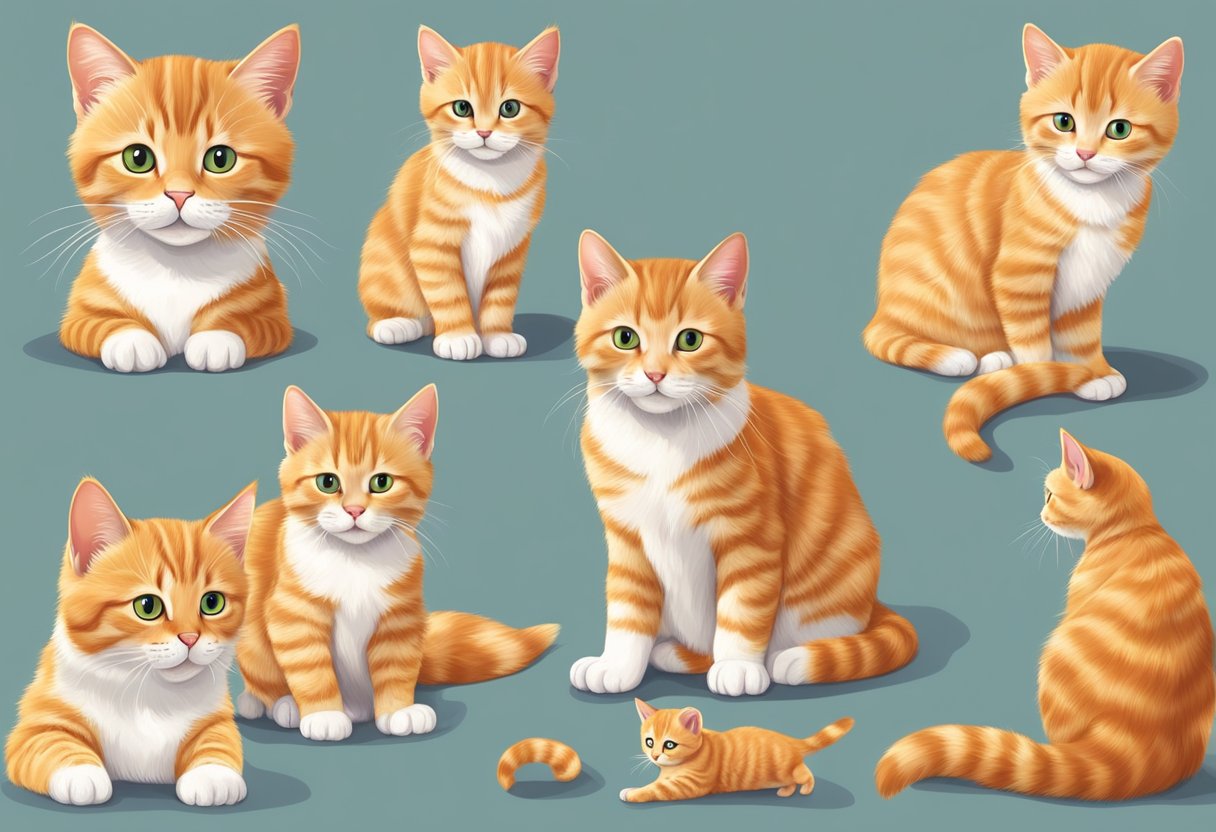
Understanding the development stages of cats, particularly the orange tabby varieties, helps in assessing their growth and overall health.
Kittenhood (0-6 months): This stage is marked by rapid growth and development. Kittens learn to socialize, play, and develop physical coordination. Initial vaccinations occur during this period, and it’s generally the time when neutering or spaying can safely be performed.
Juvenile (6-12 months): They are no longer small kittens and start to resemble adult cats in size and behavior. Despite looking grown, they continue to learn from their environment and interactions.
Adulthood (1-6 years): In this phase, orange tabbies, whether male or female cats, will have reached their full size and develop a settled temperament. Their nutrient requirements may change, and they usually require less energy-dense diets compared to their kitten phase.
Mature Adulthood (7-10 years): Cats at this stage may be less active and are prone to age-related issues. Preventative health care becomes crucial.
Senior (11-14 years) and Geriatric (15+ years): During the senior and geriatric stages, cats often require more medical attention. Health screenings for common age-related diseases are recommended to prolong their quality of life.
Here’s a quick overview for reference:
| Stage | Age | Focus |
|---|---|---|
| Kittenhood | 0-6 months | Growth, vaccination, socialization |
| Juvenile | 6-12 months | Continued growth, learning |
| Adulthood | 1-6 years | Maintenance, active lifestyle |
| Mature Adulthood | 7-10 years | Health monitoring, less activity |
| Senior to Geriatric | 11+ years | Increased health care, monitoring |
Regular veterinary visits and attentive care can help ensure that an orange tabby cat lives a happy, healthy life during each of these pivotal development stages.
Frequently Asked Questions
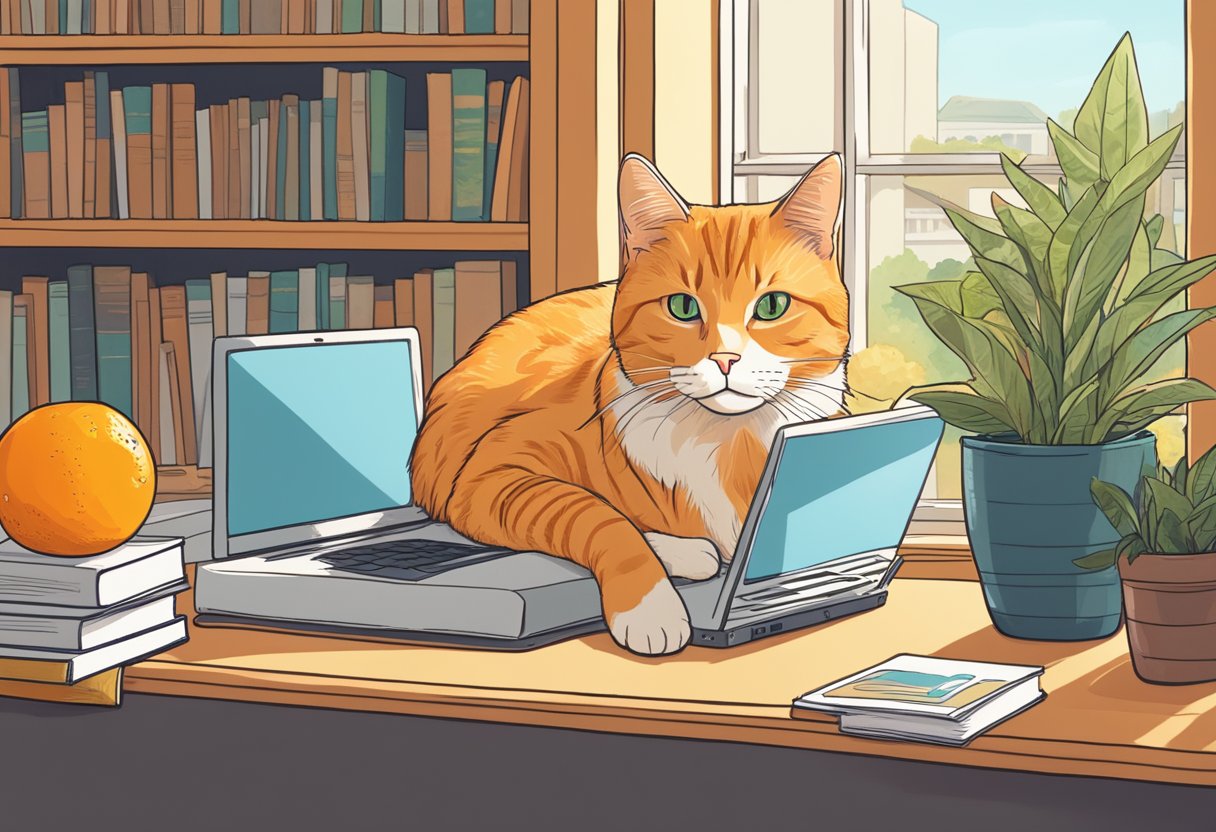
This section answers common queries regarding the lifespan and characteristics of orange tabby cats, focusing on their typical longevity indoors and outdoors, potential health concerns, distinctive personality traits, and influencing factors of their life expectancy.
What is the average lifespan of an indoor tabby cat?
Indoor tabby cats typically enjoy longevity ranging from 12 to 16 years, with some living well beyond this average under optimal care.
Are there any specific health issues associated with orange tabby cats?
While not linked directly to their coloration, orange tabby cats can experience common feline health issues; however, no specific diseases are unique to orange tabby cats.
Do outdoor tabby cats have a shorter lifespan compared to indoor ones?
Yes, outdoor tabby cats generally have a shorter lifespan due to risks such as accidents, predators, and exposure to diseases, making their life expectancy shorter than that of indoor tabby cats.
What are the distinct personality traits of an orange tabby cat?
Orange tabby cats are often recognized for their affable and sociable personalities, along with being highly intelligent and playful.
What factors can impact the longevity of tabby cats?
The longevity of tabby cats can be influenced by a variety of factors including genetics, diet, exercise routine, and routine veterinary care, which collectively contribute to their overall well-being.
Which cat breed is known to have the longest lifespan?
Some cat breeds, such as the Siamese and Manx, are known to have longer lifespans, often reaching into their late teens or early twenties, under ideal conditions.
